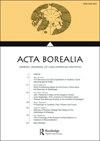Multilingual encounters in Northern Norway
IF 0.6
4区 社会学
0 HUMANITIES, MULTIDISCIPLINARY
引用次数: 1
Abstract
Norway has always been a multilingual society; Sámi languages have been spoken in vast geographical areas since prehistoric times, the Kven and other historical minority groups settled in the country, the Norwegian language has a great variety of dialects and the long coastline has eased mobility and enabled multiple multilingual encounters lasting short or long periods of time. In recent years, migrants from all over the world have become part of Norwegian society (Bull and Lindgren 2009). The practice and evaluation of multilingualism in its broadest sense have changed over the years, and new arenas in which multilingual encounters take place have emerged. The articles in this issue of Acta Borealia highlight a handful of aspects of these developments, as seen from the point of view of contemporary Northern Norway. The articles are written by members of the Multilingual North: Diversity, Education and Revitalization (MultiNor) research group at UiT The Arctic University of Norway. Although the articles in this special issue primarily concern multilingualism in contemporary settings, they are all rooted in the historical contexts of the northernmost region of Norway. Here, colonization and Norwegianization politics (from approximately 1860– 1950) have immensely influenced people’s multilingual lives, and the consequences are still highly present. Norwegianization promoted the use of the Norwegian language and stigmatized the use of the Sámi and Kven languages. This delegitimization had severe consequences. In many communities, there were language shifts from Sámi and Kven to Norwegian, and these languages are today considered endangered or severely endangered. However, since the Sámi and Kven languages were used privately and hidden from public arenas, they were not completely erased, and there is still a basis for their (re)vitalization and reclamation. These processes are now supported in the very same arenas where these languages were sanctioned, namely educational institutions, workplaces and public arenas (e.g. Huss 2008; Huss and Lindgren 2010; Pietikäinen et al. 2010). Historically, transnational migration to Northern Norway (e.g. Brochmann and Kjeldstadli 2014; Hiss 2017) contributed to linguistic diversity though not to the extent that can be seen in the twenty-first century. The Norwegian minority policy and the development of linguistic diversity in Northern Norway have been described in three main historical phases (e.g. Niemi 1995; Huss and Lindgren 2010). In the first phase, which lasted until the 1860s, the policy was described挪威北部的多语言交流
挪威一直是一个多语言社会;自史前以来,萨米语就在广阔的地理区域使用,克文人和其他历史上的少数民族定居在该国,挪威语有多种方言,漫长的海岸线缓解了流动性,并使多种语言的交流能够持续短时间或长时间。近年来,来自世界各地的移民已成为挪威社会的一部分(Bull和Lindgren,2009年)。多年来,对最广泛意义上的多语制的实践和评价发生了变化,出现了多语言交流的新领域。从当代挪威北部的角度来看,本期《北方学报》的文章强调了这些发展的几个方面。这些文章由挪威北极大学北方多语言:多样性、教育和振兴(MultiNor)研究小组的成员撰写。尽管本期特刊中的文章主要涉及当代环境中的多种语言,但它们都植根于挪威最北部地区的历史背景。在这里,殖民化和挪威化政治(大约从1860年到1950年)极大地影响了人们的多语言生活,其后果仍然存在。挪威化促进了挪威语的使用,并污蔑了萨米语和克文语的使用。这种剥夺合法性的做法产生了严重后果。在许多社区,语言从萨米语和克文语转变为挪威语,这些语言今天被认为是濒危或严重濒危语言。然而,由于萨米语和克文语是私人使用的,不在公共场合使用,它们并没有被完全抹去,它们的(重新)复兴和开垦仍然有基础。这些程序现在在这些语言被批准的同一领域得到支持,即教育机构、工作场所和公共领域(例如Huss 2008;Huss和Lindgren 2010;Pietikäinen等人2010)。从历史上看,跨国移民到挪威北部(例如Brochmann和Kjeldstadli,2014年;Hiss,2017年)促进了语言多样性,尽管没有达到21世纪的程度。挪威少数民族政策和挪威北部语言多样性的发展分为三个主要的历史阶段(例如,Niemi 1995;Huss和Lindgren,2010年)。在持续到19世纪60年代的第一阶段,该政策被描述为
本文章由计算机程序翻译,如有差异,请以英文原文为准。
求助全文
约1分钟内获得全文
求助全文

 求助内容:
求助内容: 应助结果提醒方式:
应助结果提醒方式:


